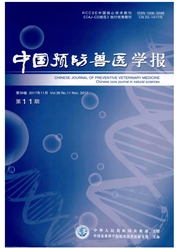

 中文摘要:
中文摘要:
为研究两株H7亚型流感病毒A/chicken/Jilin/SD020/2014(H7N2)(简称JL/020)和A/Anhui/1/2013(H7N9)(简称AH/1)受体结合特异性差异的影响机制,本实验利用反向遗传操作技术,构建一系列重配病毒和HA基因点突变病毒,检测其对受体结合特性的影响。固相ELISA检测结果表明血凝素蛋白(HA)中的57和312位氨基酸不影响流感病毒的受体结合特性,而神经氨酸酶蛋白(NA)使r-JL/020fAH/1骨架1结合SAa2,3Gal受体的结合能力高于r-AH/1(R57K/R312K),表明NA影响了流感病毒受体结合特性;同源建模进一步发现HA中的57和312位点与流感病毒受体结合结构域相距较远;交叉血凝抑制试验(HI)结果表明,H7单因子血清和H7N9全病毒血清对拯救的JL/020和AH/1病毒株的抑制价没有差异,而N2单因子血清对病毒的抑制能力存在差异。以上结果表明,NA蛋白影响了流感病毒的受体结合特性。本研究表明,除HA以外,NA也能够影响流感病毒的受体结合特性,该实验为进一步研究流感病毒受体结合特性提供了实验依据。
 英文摘要:
英文摘要:
Two H7 subtype influenza viruses, A/chicken/Jilin/SD020/2014 (H7N2) (JL/020) and A/Anhui/1/2013 (H7N9) (AWl), were selected to study the mechanism of receptor-binding specificity in this study. To investigate which factor influences the receptor-binding property, a series of reassortants and mutant viruses were constructed by using 8 plasmid-based reverse genetics. Solid-phase ELISA assay showed that the receptor-binding specificity of AH/1 was not affected by the R57K and RInK mutations in HA, while N2 NA increased the binding affinity against SAet2,3Gal of r-JL/020(AH/1 backbone), indicating that NA influenced the receptor-binding property. Homologous modeling further showed that the aa57 and aa312 in HA were not located in the receptor-binding domains. The hemagglutination inhibition (HI) antibody titers of the H7 HA single factor and H7N9 whole virus sera against JL/020 and AH/1 virus were both 4 and 7, respectively, while the HI titers of the N2 NA sera against the two viruses were different. All these results indicated that NA protein influenced the receptor-binding properties. This study demonstrates that, in addition to HA, NA has also an important role on receptor-binding specificity of influenza A virus, which provides a basis for further study of receptor-binding properties.
 同期刊论文项目
同期刊论文项目
 同项目期刊论文
同项目期刊论文
 期刊信息
期刊信息
